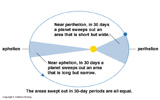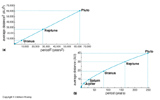Wednesday, June 5th 2002. Reading: Cosmic Perspective Chapter 5
Islamic scholars salvaged what they could from the dying Hellenic culture and created their own center of knowledge in Baghdad (in modern day Iraq). They built a library that rivaled that in Alexandria. They combined the knowledge of the East and the West. Made great mathematical contributions by inventing Algebra. Made careful observations of the heavens.
During this time the geocentric model of Ptolemy was still used but the Arab scholars found it necessary to continue to modify the model adding epicycle within epicycle. At one point the geocentric model had as many as 80 epicycles within epicycles. Quite ridiculous!
When the Byzantine capital of Constantinople fell in the 15th Century AD many Eastern scholars fled into Europe and brought with them the knowledge they had been accumulating over the centuries. This return of Classical knowledge and tradition to Europe marked the beginning of its Renaissance after a long period of darkness.

Martin Luther described Copernicus as an "upstart astrologer". He cited biblical scripture where Joshua commands the Sun to stand still and not the Earth as disproof.
In 1616 the Catholic Church place the work on a list of banned books, until all copies could be "corrected" by local ecclesiastical censors. It remained on this list until 1835. A recent survey of medieval texts found the censorship to have been ineffective. Only 60% of copies in Italy were censored and none had been in Iberia.
Some of Copernicus' supporters suggested that Copernicus himself had never truly believed in the model, but found it more convenient for calculating planetary motions than Ptolemy's cumbersome geocentric model.
Key Point
Copernicus' model did not do any better at predicting the positions of planets than did Ptolemy's model, but it did just as well. This is mainly because Copernicus assumed that planetary orbits were circular. They are not. Also people stubbornly held onto Aristotelean physics. If the Earth moves why do the stars not exhibit parallax? Some scholars at the time suggested that perhaps the stars were so far away that their parallax could not be measured. Then there was the argument as to the fact that we do not feel the Earth move. How can it then be moving? It would take Newton to explain this. Thus Ptolemy's model still held sway for at least the next 50 years. But its time was at hand.
He eventually left the seminary and went off to study for the clergy. It was here that his teachers exposed him to the dangerous mysteries of Copernicus' heliocentric Universe. This idea resonated strongly with Kepler. The Sun was a metaphor for God in his mind and it seemed right to have the Universe revolve around it paying homage.
Before becoming ordained Kepler took a job as a teacher in Graz, Austria. There he taught middle school mathematics. He was a terrible teacher, and his students payed his lectures little attention. It was while in the midst of one of his long dronings that an idea struck him. This idea would forever change the course of Astronomy. There were only 6 planets known in Kepler's time. He wondering why only 6? Why not 1 or 20? Why did they have the spacing deduced by Copernicus? There were known to be only 5 perfect solids, whose sides were regular polygons. Kepler's idea was that the two numbers must be connected. There are only 6 planets because there are only 5 perfect solids. He thought that the solids when inscribed or nested one within the other would specify the distances of the planets from the Sun. He believed that he had envisioned the invisible support structure for the planetary spheres. He called this revelation The Cosmic Mystery. In this connection he believed there could be only one explanation: The Hand of God, Geometer.
Kepler tried and tried to build a model that would fit his idea of the nested solids to the spacings inferred by Copernicus. He could not. When he finally realized that it was simply not possible, he did what all good theorists do: he sought better data...
Enter Tycho Brahae.
Tycho was born of Danish nobility and was flamboyant, boisterous, and arrogant. He wore a golden nose, his original nose having been lost in a student duel over who was the better mathematician. His goal in life was to be the greatest naked eye observer that ever lived. He claimed to all that would listen that he was. He was right. Using his great wealth he designed instruments that were more accurate at measuring angles and positions in the sky than any other such device previously known. Tycho rejected the heliocentric theory on the basis that if it were true stellar parallaxes must be measured. Since not even he was capable of this he concluded that it must not be so. He preferred a hybrid model in which all of the other planets went about the Sun and the Sun went about the Earth.
Despite the argument that had lost him his nose he was not a great mathematician and he knew it. Thus he was not fully equipped to make sense of the extremely accurate data that he had been amassing on the motions of the planets. The irony in this was that he had been appointed to the post of Imperial Mathematician in the court of the Holy Roman Emperor, Rudolf II. Tycho had heard of a brilliant young mathematician by the name of Kepler and invited Kepler to join him in Prague. In 1598 Kepler's school was closed by order of the local Catholic archduke and Kepler was exiled. He decided to take Tycho up on his offer.
The two men were as different as night and day. Kepler was a monkish, pious, and scholarly country bumpkin. Tycho was a party animal, continuously surrounded by a rowdy entourage of revelers who often mocked poor Kepler. The two men distrusted one another. Tycho only gave Kepler little scraps of his data at a time and Kepler kept his findings a secret from Tycho.
During one particular festivity Tycho was in the company of the Baron of Rosenberg. He had drank quite excessively and was in dire need to relieve himself. But he felt that it would be disrespectful to the Baron to excuse himself. So he held it... as a result he developed a nasty urinary tract infection and ignored his doctors' advise to lay off the excessive drinking and eating. In just a few short months he was dead.
On his deathbed Tycho repeated deliriously to Kepler, "Let me not seem to have lived in vain...Let me not seem to have lived in vain." He did not.
After Tycho's death Kepler inherited the sum of all Tycho's work. Tycho had data for the planets over the course of many years. The precision was exquisite. He used the same method as Copernicus to determine the distance of Mars from the Sun at various places in its orbit. He started with Mars, because its orbit was the one that did not fit his nested solids model the most. Much to his dismay this newer, and better data did not conform to his model either. After 3 years of intense mathematical calculations Kepler made a brave decision. He abandoned his idea and concluded that the planetary orbits were not circles afterall as has been assumed by everyone previous to him. The data simply did not support it. In fact the data outright demanded the correct answer: the planets orbit the Sun in ellipses. Kepler's work would eventually lead him to formulate 3 laws of planetary motion:




Well, Kepler's 3rd law states that:
Kepler now wondered what would cause the planets to slow down in their orbits as they move away from the Sun and speed up as they approach the Sun. He suggested that there was some force akin to magnetism (which was known at the time) that the Sun exerts on the planets. Kepler was foreshadowing the discovery of gravity by Isaac Newton as that force.
Galileo was a contemporary of Kepler's and the two corresponded with each other over their respective discoveries. Galileo had seen a Dutch spectacle maker demonstrate a new instrument which he called a telescope. Galileo built his own telescope and made some minor modifications. He turned the telescope to the stars and again the Universe was forever changed. Through his telescope Galileo observed:

Galileo published his observations and interpretations touting the heliocentric model widely. He made no attempt to hide these discoveries, and it got him into a lot of trouble. In 1633 Galileo was compelled to stand trial for "vehement suspicion of heresy" by the Catholic Church. The Church had liked the idea of a Universe centered on Earth. It had taught the Ptolemaic model as the correct one reinforced by biblical scripture. Galileo was threatened with excommunication and death if he did not recant his claims. Eventually he capitulated. There is a story (likely apocryphal) that when Galileo recanted his belief that the Earth went around the Sun to the Church court he muttered under his breath so that only those nearest could hear him say, "and yet, it moves."
Galileo was placed under house arrest for the remainder of his life. It was hardly a punishment. He continued to do physics experiments involving rolling balls on inclined surfaces, studying the motions of a pendulum, and dropping balls of different masses to see which would fall fastest. The results of his experiments and his interpretations would later lead Newton to reinvent physics and once again change the Universe.
Return to Class Notes Page